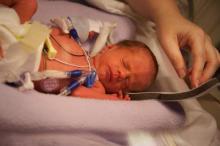Inhaled budesonide delivered within 24 hours of birth decreases the incidence of bronchopulmonary dysplasia in extremely preterm neonates, but this benefit may be offset by a possible increase in mortality, according to a report published online Oct. 15 in the New England Journal of Medicine.
Systemic glucocorticoids reduce the rate of bronchopulmonary dysplasia but appear to cause severe short- and long-term adverse effects including intestinal perforation and cerebral palsy. Administering the drugs by inhalation may avert these adverse systemic effects, but until now most studies of this mode of delivery have been small, haven’t initiated the treatment immediately after birth, and have produced inconclusive results. So researchers performed a large double-blind placebo-controlled randomized trial in which inhaled budesonide or a matching placebo was administered within 24 hours of birth to 863 extremely preterm neonates.
The infants were treated at 40 medical centers in nine countries during a 3-year period, until they no longer needed supplemental oxygen and positive-pressure support or reached a postmenstrual age of 32 weeks, said Dr. Dirk Bassler of the department of neonatology, University Hospital Zurich, and his associates.
The primary outcome measure – a composite of death or bronchopulmonary dysplasia at 36 weeks postmenstrual age – occurred in 40% of the budesonide group and 46% of the placebo group (relative risk, 0.86), indicating that the active drug produced a benefit of borderline significance, Dr. Bassler and his associates noted (N Engl J Med. 2015 Oct 14; doi: 10.1056/NEJMoa1501917). However, when the two components of the composite outcome were examined separately, inhaled budesonide was significantly better than was placebo at reducing the rate of bronchopulmonary dysplasia but was associated with a nonsignificant excess in mortality. The lung disorder developed in 28% of neonates assigned to active treatment and in 38% of those assigned to placebo (RR, 0.74), while mortality was 17% for budesonide and 14% for placebo (RR, 1.24). Notably, the nonsignificant difference in mortality may have been due to chance, the investigators said.
Budesonide also significantly reduced the incidence of two important secondary outcomes: patent ductus arteriosus requiring surgical ligation (RR, 0.55) and the need for reintubation after completion of the study drug (RR, 0.58). The therapy did not offer any benefit over placebo in the frequency of all other secondary outcomes, including retinopathy of prematurity, brain injury, necrotizing enterocolitis, patent ductus arteriosus requiring medical treatment, infections, oral candidiasis requiring treatment, hypertension requiring treatment, hyperglycemia requiring treatment, length of hospital stay, increase in weight or head circumference, and age at the last use of respiratory pressure support.
The rates of adverse events did not differ significantly between the two study groups.
The overall efficacy of early inhaled budesonide, as well as its associated risks, cannot be ascertained from these short-term outcomes alone. “Follow-up of our study cohort, including assessment of neurodevelopmental outcomes at 18-22 months of corrected age, is currently under way,” Dr. Bassler and his associates wrote.
This study was supported by the European Union and Chiesi Farmaceutici. Chiesi supplied the study drugs free of charge and Trudell Medical International supplied free spacers for the inhalers. Dr. Bassler and three of his associates reported receiving grant support and personal fees from Chiesi Farmaceutici. The other authors reported no relevant financial disclosures.


